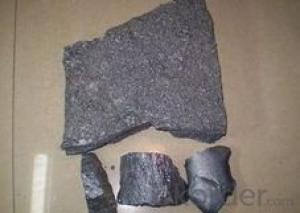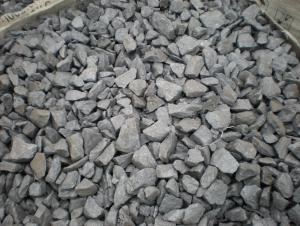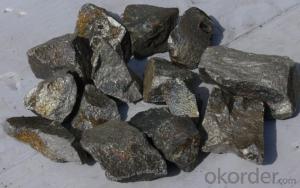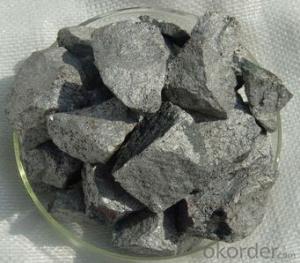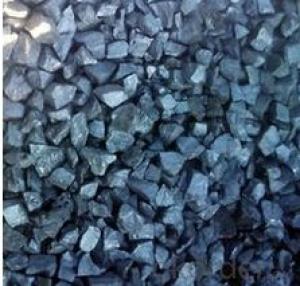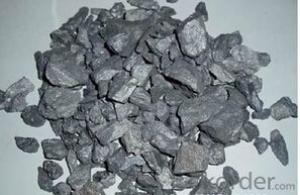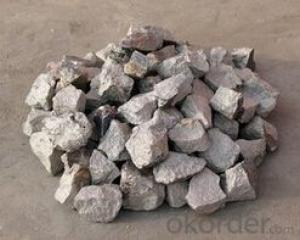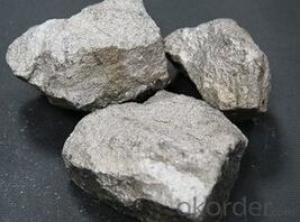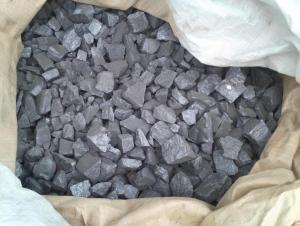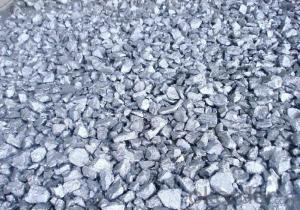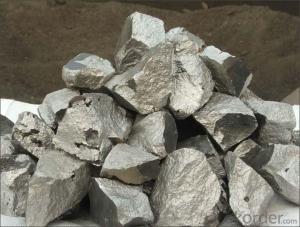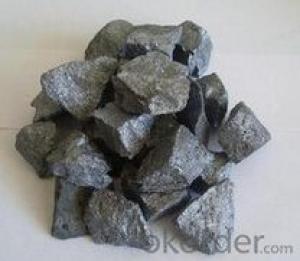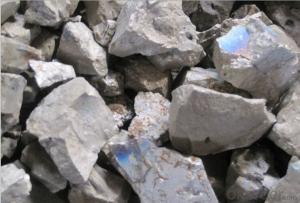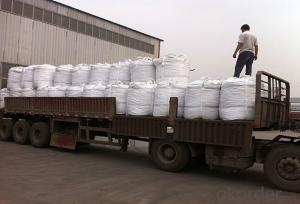Good Quality Fesi Products
- Loading Port:
- China Main Port
- Payment Terms:
- TT OR LC
- Min Order Qty:
- -
- Supply Capability:
- -
OKorder Service Pledge
OKorder Financial Service
You Might Also Like
Discription:
Ferro silicon is an atomized alloy,which is formed by combining iron and silicon with a silicon content range of 15% to 90%.Ferro silicon is a universal “heat blocker” used in the production of carbon and stainless steels.
Specification:
Chemical composition:
| Grade | chemical composition(%) | |||||||
Si | Al | Ca | Mn | Cr | P | S | C | |
≤ | ||||||||
FeSi75 | 75 | 1.5 | 1 | 0.5 | 0.5 | 0.04 | 0.02 | 0.2 |
FeSi72 | 72 | 2 | 1 | 0.5 | 0.5 | 0.04 | 0.02 | 0.2 |
FeSi70 | 70 | 2 | 1 | 0.6 | 0.5 | 0.04 | 0.02 | 0.2 |
FeSi65 | 65 | 2 | 1 | 0.7 | 0.5 | 0.04 | 0.02 | 0.2 |
FeSi60 | 60 | 2 | 1 | 0.8 | 0.6 | 0.05 | 0.03 | 0.3 |
FeSi45 | 40-47 | 2 | 1 | 0.7 | 0.5 | 0.04 | 0.02 | 0.2 |
Size: 10-100mm
Packing: In 1 MT big bag with bottom spout.
Chemical composition and size above can be optimized according to custom's requirement.
Detailed application:
1.Ferro silicon is often used as deoxidizer in steel making.
2.Ferro silicon also can be used as alloy elements join agent,which is widely used in low alloy steel,non-ferrous metal,bearing steel,heat-resistant steels and electrician silicon steel.
3.Ferro silicon commonly used as a reductant in ferroalloy production and chemical industry.
4.In iron industry,it often used as inoculant and nodulizer and deoxidizer.
FACTORY:
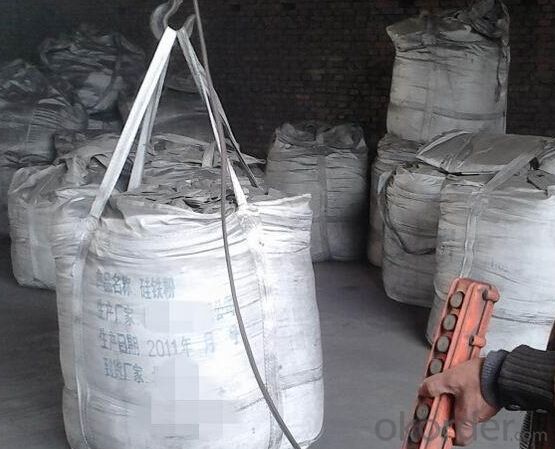
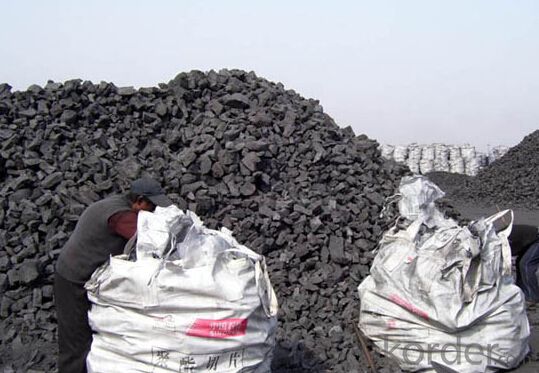
- Q:Now on the market scrap carbide blade (YG8 milling cutter) how much is one kilogram?
- Now on the market scrap carbide blade about 100 yuan / kg, depending on the alloy composition, trading area and fixed.Cemented carbide is a kind of alloy material made by powder metallurgy process of hard metal and bonding metal of refractory metal.
- Q:What is the difference between the raw and recycled materials of cemented carbides? The more specific, the better
- Raw raw materials are raw materials, recycled materials have been used, and then recycled and re produced, raw materials than recycled materials used, and more pure materials.
- Q:What is the difference between the production process of ferrous powder metallurgy and cemented carbide?
- In 1890, the invention of tungsten powder, made by powder metallurgy, in the United States, laid the foundation of modern powder metallurgy. Around 1910, it has been made by powder metallurgy method of tungsten and molybdenum products, hard alloy, bronze bearings, porous filters, brush set, and gradually formed a complete set of powder metallurgy technology. In 1930s, after the advent of the vortex grinding iron powder and the carbon reduced iron powder, the iron based mechanical parts made by powder metallurgy have gained rapid development.
- Q:How are cemented carbides sintered?
- Raw materials according to the provisions of the proportion of added alcohol or other medium in the wet ball mill in wet grinding, making them fully mixing, crushing, drying, sieving after adding wax or gel forming agent of a class, and then drying and sieving to prepare a mixture. Then, when the mixture is granulated and pressed and heated to a point near the bonding metal (1300~1500 DEG C), the eutectic alloy is formed by the hardening and bonding of the metal.
- Q:What is the hardness of the carbide thread?
- The hardness of cemented carbide tools is generally between 89~92.8, such as the hardness of YG8 is HRA89, the hardness of YT30 is 92.8, and the hardness of YT15 is 91.
- Q:What kind of cemented carbide is used for processing HRC40 degrees stainless steel?
- It is recommended to choose YS8 welding tool. Very good processing quality can be obtained.
- Q:How hard is the carbide knife?
- Seven or eight, Baidu is absolutely no problem.
- Q:Tungsten carbide cutter white steel cutter carbide cutter is what is the difference?
- They are hard and not afraid of annealing, but they are brittle. Also called tungsten titanium alloy. Hardness can range from HRB89 to 95, with characteristics that are difficult to wear.
- Q:What are the types, codes, and range of application of cemented carbides?
- I am also engaged in carbide industry, different grades (there are ISO brand, there are some domestic brands, and some even use the manufacturer's own brand) on behalf of the composition and use of the barrier.. Because of the wide variety of brand names, the average person will only involve one or several specific industries, and there is no need to know all the code names and their detailed performance... Therefore, we usually produce or recommend the brand (code name) according to the performance and use of the customer..Customers are generally in order before provide you with detailed performance parameters, although not in the factory name brand in different, but according to the performance parameters of the still commonly found in different plant in the corresponding or similar grades, but some brands of blade complex, and complex composition, tell you some properties can not be done with the original brand as like as two peas.. In the blade field, there is still a big gap between China and foreign countriesAlso, due to the development of hard alloy, grade ISO has lost his original meaning of..K20, K30, K40, K05.. And so on, people don't seem to know what they want, if my client told me that these ISO grades, I basically have to provide him with detailed performance parameters..Friends, you are in that industry, our company mainly engaged in geological and mining products (ball gear, drill chip, pick, engineering, knife, shovel snow tooth.Etc)
- Q:Can ceramic tools process cemented carbides?
- No, ceramic cutters are usually used to process cast iron (high speed machining) and high hardness steel (Cui Huogang).Generally, the hardness of ceramic tools reaches HRA91-95, while the hard alloy can reach HRA93.The main components of ceramic tool materials are Al2O3 with high hardness and melting point. Si3N4 and other oxides and nitrides, and then added a small amount of metal carbide, oxide or pure metal additives, formed by pressing, sintering, and then a tool material. Its hardness can reach HRA91 ~ 95, and the hardness of HRA80 can still be kept at the cutting temperature of 1200 DEG C. In addition, the chemical inertia is large, the friction coefficient is small, and the wear resistance is good, and the service life of the processed steel pieces is 10~12 times of that of the hard alloy.Its major disadvantages are brittleness, low bending strength and low impact toughness. Therefore, it is mainly used for semi finishing and finishing, high hardness, high strength steel and chilled cast iron and other materials. Commonly used ceramic cutting tools are alumina ceramics, composite alumina ceramics and composite silica ceramics.Taiwan is hard gold metal carbide with high heat resistance and high wear resistance (WC tungsten carbide, titanium carbide, tantalum niobium carbide TiC TaC, NbC etc.) and metal binder (cobalt, nickel and molybdenum) powder metallurgy products under high temperature sintering. The hardness of HRA8 9 ~ 93, 850 ~ 1000 DEG C high temperature resistant, has good abrasion resistance, allowing the use of the cutting speed can reach 100 ~ 300m / min, can be a variety of materials including machining hardened steel, therefore it is widely available.
1. Manufacturer Overview |
|
|---|---|
| Location | |
| Year Established | |
| Annual Output Value | |
| Main Markets | |
| Company Certifications | |
2. Manufacturer Certificates |
|
|---|---|
| a) Certification Name | |
| Range | |
| Reference | |
| Validity Period | |
3. Manufacturer Capability |
|
|---|---|
| a)Trade Capacity | |
| Nearest Port | |
| Export Percentage | |
| No.of Employees in Trade Department | |
| Language Spoken: | |
| b)Factory Information | |
| Factory Size: | |
| No. of Production Lines | |
| Contract Manufacturing | |
| Product Price Range | |
Send your message to us
Good Quality Fesi Products
- Loading Port:
- China Main Port
- Payment Terms:
- TT OR LC
- Min Order Qty:
- -
- Supply Capability:
- -
OKorder Service Pledge
OKorder Financial Service
Similar products
New products
Hot products
Related keywords
